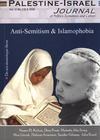The children in these photos are certainly not ugly. Their mothers, in the cases I was able to witness, love them dearly. However, they are all, in my eyes, the living Handhala: poverty stricken children, living in conditions that are unfit for strong adults. Indeed, I wonder if their growth, like that of their ink and paper equivalent, in some form or another is stunted as a result of their conditions. How can we claim this is a normal childhood?

Balata refugee camp school girls
Children, a Source of Hope
However, the children are the source of hope. Ali, speaking of his time in Beirut in the early 1970s said "[I] faced armies with cartoons and drawings of flowers, hope and bullets. Yes, hope is essential, always." In my mind Handhala was always the hope - he was a child, naïve, but never dumb and always aware. He never surrendered. Not in the face of armies, occupation, oppression, censorship or corrupt regimes and parties.
The children in this exhibition are the hope. Their smiles, their antics, their gait and everything else that makes them children is passed on to us, the viewers, and thereby extends to us the naïve hope that emanates from them simply because of who they are. They do not realize the heavy burden they carry on their shoulders as the future. This allows them to grin, frolic and ignore the world around them. The children, like Handhala, are naïve, but not dumb. They are suspicious, but not paranoid. They are stronger than they appear.

Three kids in Aqaba refugee camp
The Palestinian narrative has many painful moments. What is striking, however, is that those who make up the narrative, the Palestinian people as individuals, are not as negative as their story. Though many families have lost loved ones or have had them locked away in prisons, I have learned while visiting the camps that the Palestinian home is not one of gloom and doom. One of the shining points of each home is always the children and grandchildren - indeed the family unit is still precious in this society. These youngsters manage to put smiles on the wrinkled faces of the elderly and turn a dwelling in a refugee camp into a home - even if the home is still in a camp and the whole situation is supposed
 to be temporary.
to be temporary.The children, at least once they reach a certain age, are aware of their plight - if not to the same extent that Handhala is aware, at least to a larger sense than we might expect. They absorb their environment. However, they persevere in a way which must be admired.
Real Life
These photographs are essentially candid moments - or as real as I could make them - in the lives of these youngsters. None of
 these children knew they were to be photographed,
no preparations were made, very little if any posing was done -the
people were photographed as they were on the street when, by
chance, I happened upon them. None of them knew for what purpose
they were to be photographed, as I myself did not know what to do
with the photographs.
these children knew they were to be photographed,
no preparations were made, very little if any posing was done -the
people were photographed as they were on the street when, by
chance, I happened upon them. None of them knew for what purpose
they were to be photographed, as I myself did not know what to do
with the photographs.I thank them for allowing me to steal a moment of their lives. I hope that all they have lost will be returned to them. I would like to watch Handhala grow up.

